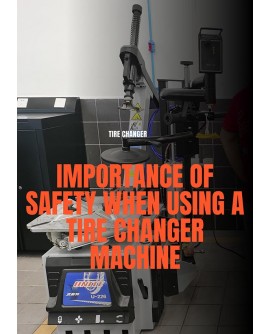
Importance of Safety When Using a Tire Changer Machine
06/03/2025 | Unite Automotive Equipment
When working with a UNITE tire changer, safety should always be the top priority. These machines are essential tools for automotive shops, enabling efficient tire mounting and dismounting. However, improper usage or neglecting safety measures can lead to serious accidents. This comprehensive guide highlights critical safety practices and guidelines to ensure a safe working environment while using a UNITE tire changer.
Understanding Hazard Levels
Safety begins with understanding the potential hazards associated with UNITE tire changers. These machines are equipped with advanced features designed to enhance performance, but they also introduce unique risks that must be carefully managed. Hazards can range from damaged beads and mismatched tires to improper inflation and operator errors. Each risk poses the potential for serious injury or even death if not addressed promptly.
Definitions of Hazard Levels
To effectively manage these hazards, it is crucial to categorize them into different levels based on their severity:
- Low Hazard: Minor issues like loose clothing can escalate into significant dangers if ignored.
- Medium Hazard: Situations such as rusty wheels that require immediate attention due to potential wear and tear.
- High Hazard: Critical risks like mismatched tires or rims, which could lead to catastrophic tire explosions.
Recognizing these levels allows shop owners to take preventive measures before they escalate into more dangerous situations.
Owner’s Responsibility for Safety
The responsibility for ensuring a safe working environment lies with both the shop owner and the operator of the UNITE tire changer machine. Shop owners play a vital role in creating a safety culture by providing proper training, monitoring equipment usage, and maintaining clean work areas. Operators, on the other hand, must adhere to all safety protocols, including regular maintenance checks and adherence to established workflows.
To further enhance safety, shop owners should consider implementing specific measures such as:
- Regular inspections of the UNITE tire changer machine for wear and tear.
- Providing additional training sessions focused on operator safety.
- Encouraging operators to follow a structured approach when operating the machine, including proper alignment checks before starting any operation.
UNITE offers comprehensive resources designed to help shop owners create safe work environments. Their advanced products are built with precision engineering and user-centric design principles in mind, ensuring that even the most demanding operations can be carried out safely.
Final Safety Considerations
Safety is a shared responsibility between shop owners, operators, and equipment manufacturers like UNITE. By understanding hazard levels, using appropriate protective equipment, and adhering to safety programs, one can mitigate risks associated with tire changers.
In conclusion, prioritizing safety through thorough understanding of hazard levels, implementing robust safety measures, and leveraging advanced products like those from UNITE can significantly reduce risks associated with tire changers. Remember, a commitment to safety not only protects employees but also fosters a culture of excellence that benefits your automotive business as a whole.
